A look at Megatron NLG, ERNIE, and BLOOM: GPT-3-like Large Language Models

After millions of years of evolution, the current human language is immensely complex. There are roughly 1.7 million words in the English language, including nouns, verbs, adjectives, and many others, which can be combined in billions of ways to form new sentences every time. Humans are hard-wired to speak and comprehend speech fluently, whereas computers’ language processing capabilities are still restricted. The advent of LLMs (Large Language Models) and NLP (natural language processing) is altering the status quo.
OpenAI’s GPT-3/GPT-3.5, which forms the basis of the AI chatbot ChatGPT, is one of the most popular LLMs of recent times. Due to its exceptional accuracy in producing text that appears to be authored by a person, it has generated much discussion. This innovation can be beneficial for businesses wishing to automate operations as well as regular individuals seeking specialised information. However, it is not the only LLM available; there are several others; NVIDIA’s MT-NLG, for instance, is comprised of a great deal more characteristics. Here are some of the most prominent LLMs.

What are Large Language Models (LLMs)?
Large language models employ techniques of deep learning to analyse vast quantities of text. They operate by analysing enormous quantities of text, comprehending its structure and meaning, and learning from it. LLMs are “taught” to determine word meanings and relationships. The more training data a model receives, the better it becomes at comprehending and creating language.
Large datasets, such as Wikipedia, OpenWebText, and the Common Crawl Corpus, are typically used as training data. These include vast quantities of text data, which are used by models to comprehend and generate natural language.
GPT-3
The Generative Pre-trained Transformer 3 (GPT-3) is a language model that generates human-like prose through the use of deep learning. The model, which was introduced by Open AI in May 2020 as a successor to GPT-2, can produce code, novels, poems, and much more. The model got extensive notice after the November release of ChatGPT, and it also serves as the basis for the image-generating model Dall-E. It is equipped with 175 billion trainable parameters.
ERNIE Titan LLM
Baidu, which gained its fame in search engines, has recently increased its presence in artificial intelligence. The Chinese business has created ERNIE, its own Large Language Model (Enhanced Language Representation through Knowledge Integration). Titan is an improved version of ERNIE meant to better tasks involving natural language comprehension and generation. It is pre-trained on a vast corpus of text data and may be customised for particular NLP tasks.
Although models like GPT-3 are promising, it remains challenging for users to manage outcomes and generate factually consistent output. ERNIE proposes to address this deficiency by employing a unique training technique that teaches the model to distinguish between real language and self-generated text. This also enables the model to score the text’s credibility, making it more reliable and trustworthy.
Yandex YaLM 100B
As its name suggests, YaLM 100B utilises 100 billion parameters. During training, parameters are learned and changed to optimise the model’s performance on a certain task. They determine a model’s efficacy. While the 100 billion statistic is significantly less than the 175 billion characteristics of GPT-3, YaLM stands out due to its open availability. 1.7 TB of online literature, books, and “countless other sources” were fed to a pool of 800 A100 graphics cards over the course of 65 days. This LLM, according to Yandex, is “currently the largest GPT-like neural network openly available for English.” The model has been published on GitHub under the Apache 2.0 licence, allowing for both commercial and academic use.
BLOOM
According to its developer, BigScience, BLOOM has been trained to continue text from a prompt on large volumes of text data using industrial-scale computational resources. BigScience is a global cooperation between hundreds of researchers and institutions that is housed on Huggingface. It is capable of producing output in 46 languages and 13 programming languages, which the business claims is “almost indistinguishable from human-written text.” By transforming untrained tasks into text creation tasks, BLOOM is able to execute untrained tasks. BLOOM, like GPT-3, employs around 175 billion parameters. But there is one significant difference: it is available to everyone. The training of the model lasted four months and began on March 11, 2022, using 384 80-gigabyte graphic cards on the Jean Zay supercomputer in France.
Gopher
Gopher is a dense LLM built on an autoregressive transformer. It utilises a remarkable 280 billion parameters, second only to Nvidia’s MT-NLG in terms of size (530 billion). The model was trained using MassiveText, a 10.5-terabyte dataset encompassing sources such as Wikipedia, GitHub, and Massive Web. DeepMind is a British artificial intelligence division of Alphabet Inc. that Google acquired in 2014. According to reports, Gopher outperforms GPT-3 models in areas such as mathematics, logic, knowledge, science, and reading comprehension.
MT-NLG
NVIDIA is developing Megatron-Turing Natural Language Generation in conjunction with Microsoft. It was announced as a successor to the Turing NLG 17B and Megatron-LM versions in October 2021. Microsoft announced the Turing project in 2019 with the intention of enabling AI-powered enterprise search. With 530 billion parameters, MT-NLG is the largest of its kind. It is capable of a vast array of natural language tasks, including completion prediction, reading comprehension, commonsense reasoning, natural language inferences, and word sense disambiguation. The model was trained on the sixth-fastest supercomputer in the world, NVIDIA’s Selene machine learning supercomputer.
Related Posts
| Samsung Galaxy S24 Series Update Enhances Display, Camera, and AI Capabilities |



